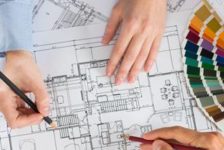If someone were to ask me who is the best contemporary landscape architect, artist and ecologist – I would immediately reply, Steve Martino! His works caught my eye many years ago, when I bought my first book about gardens. For a long time his thinking was totally out of step with the landscape profession, he had to struggle to get projects built using native plants. Over the years he has gone from being a heretic to a hero without doing anything different: society and the profession finally came around to his point of view. When I first talked to Steve, his philosophy sounded so simple, almost too obvious. But isn’t this the value of any great work of art? Here are just a few fragments of our conversations on sustainability, his style and design approach: On sustainability

Steve Martino; photo credit: Malgorzata Okolowicz
In order for a beautiful garden to have any significance , it needs to go beyond just responding to the client’s needs and conditions, it also needs to accommodate the natural environment. Our landscapes are like terminally ill patients. They are tethered to IVs and monitors and need constant attention to keep them alive. If someone pulls the plug, the garden will die. The only way to break out this situation is to use native plants. They have less of a demand for water and fertilizer, which is better spent on food crops.
My definition of sustainability has always been very simple: when the power or water is shut off, your garden should not die. On weeds and walls: Gardens consist of two worlds, the man-made and the natural one. I’ve described my garden design style as
“Weeds and Walls” – Nature and Man. I started to use native plants to simply make the transition from a building to the adjacent natural desert. It seemed like a no-brainer as a technique to visually claim the adjacent land as part of your project. I like the idea of landscape design as being the juxtaposition of man and nature at their best: in my designs I feel that ‘man’s best’ are my refined architectural elements, they represent the best I can do, and ‘nature’s best’ is the native landscape of the site and the region. It represents millions of years of evolution to just be what’s there.

A Steve Martino design full of life while still respecting the natural environment; credit: Steve Martino
I reconfigure it in ways, that may or may not be found in nature, to structure space to my liking, Then, I let the garden evolve on its own to work out spacing and dominance. I’ve found that some people do not like plants to touch, especially different species.
I not only like them to touch, I expect them to have sex. Being in the desert where the sun is so strong I have thought of sunlight as another building material that needs to be used to your advantage. The sun washes out color and flattens surfaces, so I have been forced to use walls and light to give form to space and I think I learned that from Barragan’s work.

Bright orange acts as a powerful backdrop for these native plants; credit: Steve Martino
I have always tried to make gardens that are comfortable and fit their place, in my case it’s the desert. Each project is an advancement over the previous one. I try to take what I learn on one project and push it a little farther on the next one. Isn’t this what any designer does?
My projects solve site problems and the walls are the backdrop for the’ living space’. A criticism I have of landscape design is that it can be a situation where you can spend an enormous amount of money and when you are finished, you can still have the problems you started with. I’m a fanatic about connecting the indoors with the outdoors. I think of garden design as an art form: it’s my art. I like to solve problems and to create interesting places that my clients love to be in and that are grounded to the natural processes of the site and region. You actually make your own projects and you should make them interesting. Don’t be satisfied with your first solution. Rework and refine until it’s perfect.
The perfect solution is right in front of you – you just need to find it. 
Right plant, right place! Credit: Steve Martino

Is this the garden that doesn’t need a gardener? Credit: Steve Martino
Steve Martino is recognized as a pioneering influence on the use of native plants and bold forms to achieve livable landscapes. He has just been announced as a finalist of the
James Rose Center Third International Residential Design Suburbia Transformed, which promotes works that go beyond “green” to address the aesthetic quality of human experience in the process. After so many years in the profession, he always stays on top. Article written by guest writer Malgorzata Okolowicz See Malgorzata’s Facebook page
Great!Landscapes Check more designs and updates on
Steve Martino’s website and his
Facebook page Featured image: Steve Martino
Published in Blog













